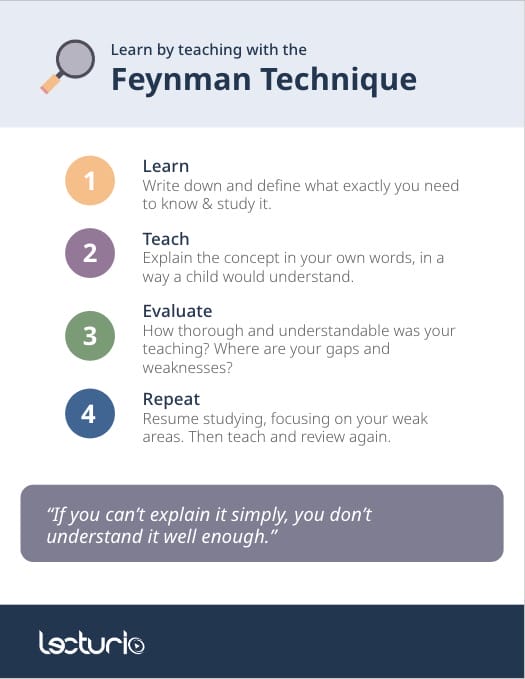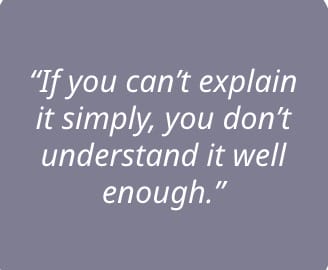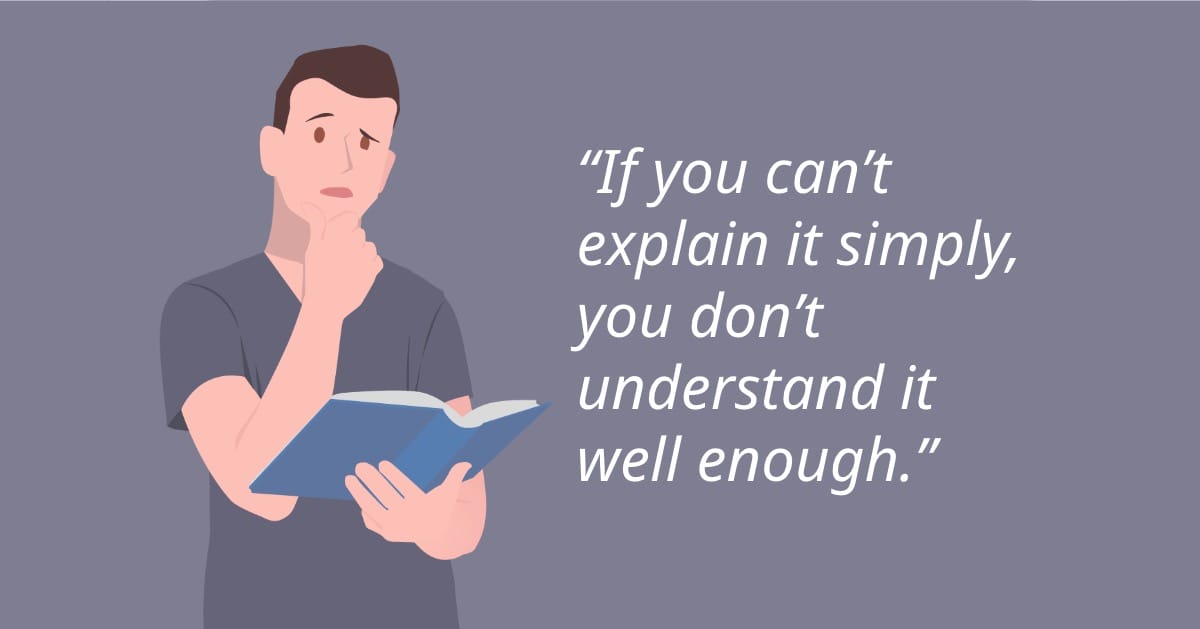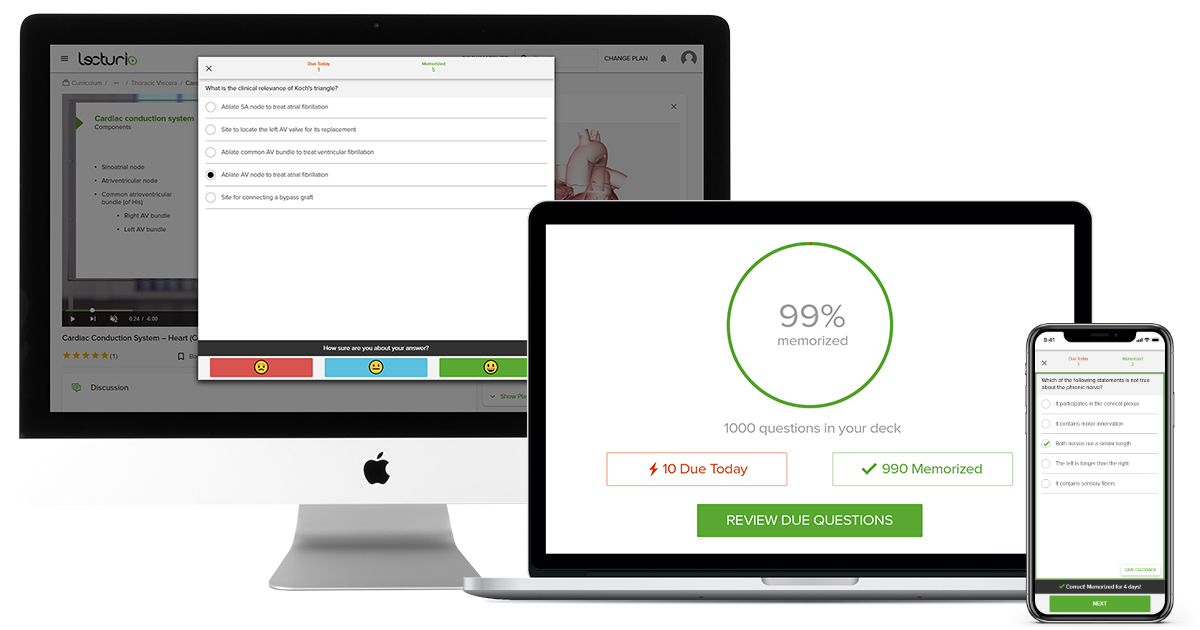What is the Feynman technique?
Definition
The Feynman technique, or Feynman method, is a learning method based on the idea that explaining a concept in simple terms makes it easier to understand and remember.
History: Richard Feynman
The technique was developed by Richard Feynman, a Nobel Prize-winning physicist who was known for his ability to explain complex concepts in a simple and accessible way. He believed in the principle that:
If you cannot explain something simply, you don’t understand it well enough.
How it works
The Feynman technique follows these four steps:
- Write down everything you know about the topic you are trying to learn.
- Teach the concept to a sixth-grader or any child.
- Review your explanation to identify areas where your teaching (and therefore your understanding) is lacking. This touches on the concept of metacognition: You need to know what you know, and what you don’t know.
- Learn more about the knowledge gaps, and repeat until you can explain the full concept in your own, simple words.


Free Download: How to use the Feynman technique (PDF)
Print the free PDF and use it as a guide to guide your study process!
Pros and cons of using the Feynman technique
The biggest strength of the Feynman technique is that it forces you to simplify complex ideas and reproduce them in your own words. While you can learn the definition or steps of a complex topic by remembering it word for word from a textbook, being able to rephrase it in the simplest terms that you come up with yourself drives it home much more effectively. It ensures you actually grasped the concept, instead of only remembering what you’ve read.
Simplifying complex topics helps you be more confident in your understanding of them. The act of teaching it then adds another dimension: While teaching and explaining, you are directly confronted with any weak areas or gaps. If you can’t teach it, you don’t know it well enough.
The more you teach and reteach it after reviewing weak spots, the more you have repeated the concept, brought it into your own words, and solidified your understanding and retention in the process.
There are potential downsides of the method to look out for:
- The additional step of teaching the concept takes time. In some situations, you simply may not have that time, or the benefit does not justify the time invested.
- Simplifying may not always work or help. Some things are just complex, and no matter how much you try, simplifying them always results in leaving out important things that just cannot be put simply. Don’t force it and potentially lose vital nuances if you feel like oversimplification is not actually helpful.
As with any learning method, try it out and remain open to decide if it works for you, or not. Learning science offers a myriad of techniques and hacks, but ultimately, the only important thing is what is effective and sustainable for you personally, and it is always recommended to actively figure that out by trying different things.
How to use the Feynman technique: practical steps for healthcare students
Healthcare students not only need to remember large amounts of information, they also need to understand complex subjects like the mechanism of action and dosing of drugs, complex metabolic pathways, or detailed pathophysiological processes.
The Feynman technique can help you gain confidence in your understanding of challenging concepts like these.
Example: Study diabetes mellitus with the Feynman technique
1. Follow your usual study routine to study up on the concept. Causes, pathophysiology, complications, diagnosis and treatment; cover everything you will need to know with your tried-and-true learning modalities.

Take the Course: Endocrinology
Sharpen core clinical skills for the interdisciplinary prevention and treatment of hormonal disorders with experienced educator Michael Lazarus, MD from UCLA.
2. When you’re done, act as if you are teaching what you’ve learned to a child: “Diabetes is a disease where your body can’t use sugar the way it should. Normally, your body turns sugar from food into energy with the help of something called insulin. But if you have diabetes, your body doesn’t make enough insulin or can’t use it right.” etc. Don’t look at your notes while you teach the concept! Only go from the overall “title” and see what you come up with.
3. Review your explanation and identify any gaps: Where were you unsure of how to say something or forgot about an important detail? If you’re unable to reproduce any parts of the concept in your own words in a simple way, it is an indication you may not have fully grasped the concept and may be more likely to be unsure about it later or have a harder time remembering it.
4. Close the gaps with additional review: Break down and simplify how you express the details you missed until you are able to freely explain them. Then, repeat the process: Teach again, review again, until you’re confident you can explain everything you need to know freely and simply.
Tip: You can apply this technique to all kinds of study situations. When you’re working through Lecturio Qbank questions, use the rationales given after your answer as a basis to make sure you have fully understood why the answer choices are correct or incorrect. You need to be able to give your reasoning so clearly a child would understand. This solidifies your confidence in your answer choices and your question-answering strategy!
Final thoughts
Using the Feynman technique can be a reliable way to reassure yourself of your understanding of complex topics. Additionally, by teaching concepts in simple terms, you not only clarify your own understanding but also already practice communicating effectively with patients and colleagues.
It addresses the common problem of patients not understanding the highly specialized language healthcare personnel use, and the professionals themselves being unable to translate the concepts into accessible language.
Connecting learning with teaching from the start could make you not just a better student, but a better healthcare professional.




